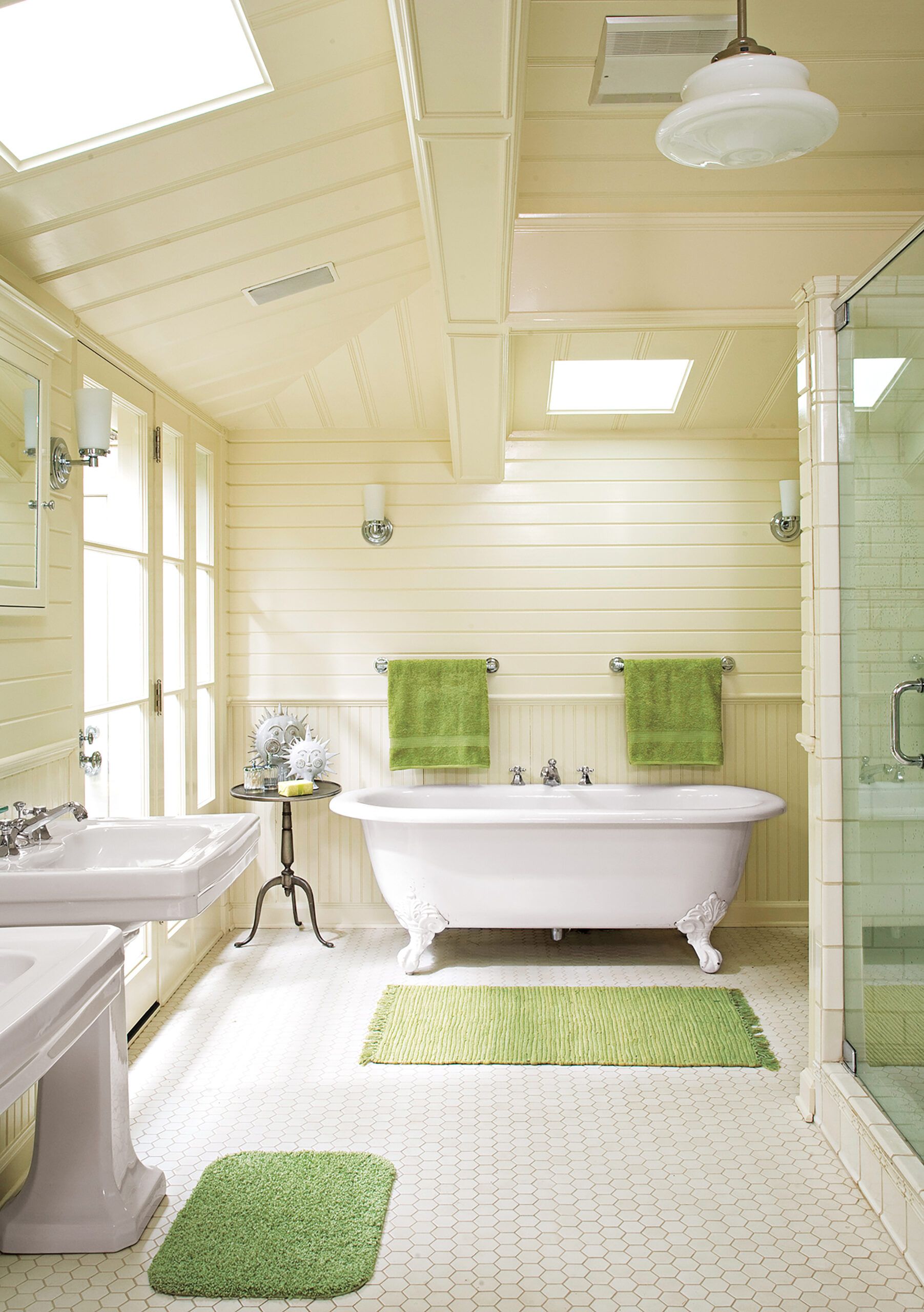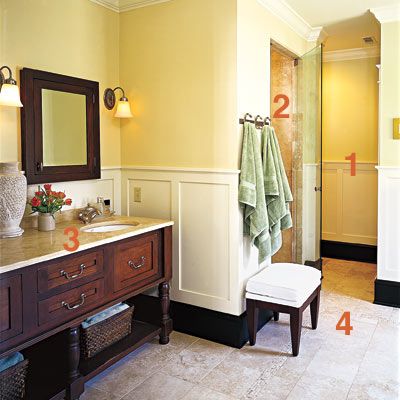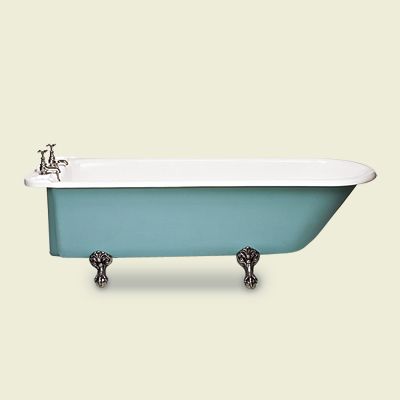A bathroom renovation can be both exciting and daunting. Whether you’re updating a powder room or overhauling a master bath, proper planning is key to a successful remodel.
In this guide, we’ll walk you through essential checklists and considerations to ensure your bathroom renovation goes smoothly, from initial assessment to final touches.
Learn more about how much you can expect to spend by reading our bathroom remodeling cost article.

Understanding the Scope of Your Bathroom Remodel
Before diving into your bathroom renovation, you’ll need a clear vision of what you want to achieve. This initial planning phase will help you set realistic expectations and make informed decisions.
Assessing Your Current Bathroom
Start by taking a critical look at your bathroom. What works well, and what needs improvement? Consider the following:
- Fixture condition and functionality
- Layout efficiency
- Lighting quality
- Storage capacity
- Ventilation effectiveness
Make a list of must-have changes and desired upgrades. This assessment will serve as the foundation for your renovation plan.
Defining Your Renovation Goals
With your current bathroom’s needs in mind, outline your specific renovation goals. Are you aiming for a complete overhaul or focused updates? Common objectives include:
- Adding luxury features like a spa tub or steam shower
- Enhancing energy efficiency
- Improving accessibility
- Increasing storage space
- Updating style
Setting a Realistic Budget
Decide how much you’re willing to invest in your bathroom renovation. Remember to allocate funds for unexpected expenses—we recommend setting aside 5–15% of your total budget for contingencies.
Essential Pre-Renovation Steps

Proper preparation is crucial for a smooth renovation. These preliminary steps will help you avoid costly mistakes and delays.
Measuring Your Space Accurately
You’ll need precise measurements to order materials and plan your layout. Measure your bathroom’s dimensions, including the placement of existing fixtures, the location of windows and doors, total floor space, and wall height. Create a detailed floor plan to help visualize your new layout and make sure everything fits as intended.
Locating Water Shutoff Valves
Locate and test all water shutoff valves before starting any demolition. This step is crucial for preventing floods. Familiarize yourself with the main shutoff valve and the individual valves for fixtures such as the toilet, sink, and shower. Make sure that these valves are easily accessible and functioning properly.
Making Backup Bathroom Arrangements
If you’re renovating your only bathroom, plan for alternative facilities during the renovation. Whether you go to a neighbor’s or rent a portable toilet, you don’t want to get caught with nowhere to go.
Planning Your Bathroom Layout
A well-designed layout is the cornerstone of a functional bathroom. Consider these factors when planning your new space.
Optimizing Space for Shared Bathrooms

Consider incorporating these features for bathrooms used by multiple people:
- Dual sinks: Place them at least 36 inches apart (measured drain to drain) for comfortable use
- Separate shower stall: Lets bathers and shower-takers clean up simultaneously
- Separate toilet room: Adds privacy and allows simultaneous use
- Wide pathways: Aim for 36–42-inch traffic lanes for easy movement
Also, make sure you have ample storage space to accommodate the number of people who will be using the bathroom.
Considering Accessibility and Future Needs
Think long-term when planning your layout. Consider features that will accommodate changing needs:
- Comfort-height toilets
- Curbless showers for easy entry
- Grab bars near toilets and in showers
- Wider doorways for potential wheelchair access
These adaptations can increase your home’s value and allow you to age in place comfortably.
Choosing Between a Tub and a Shower
Deciding between a tub and a shower depends on your preferences and space constraints. Consider these factors:
- Available space
- Frequency of use
- Resale value (homebuyers often prefer at least one tub)
- Water usage and efficiency
Thinking About Your Hot Water Heater
If you’re adding a soaker tub or multi-head shower, you may need a bigger water heater. Tank-style heaters are labeled with a first-hour rating (FHR), a measure of how much hot water they produce in an hour.
To help determine your FHR, use the list below to calculate your family’s hot water consumption in the bath each morning. Visit the U.S. Department of Energy for more info on FHR.
- Bathing: 9 gallons per person
- Shampooing hair: 4 gallons per person
- Shaving: 2 gallons per person
- Showering: 12 gallons per person
- Washing hands and face: 4 gallons per person
Selecting Bathroom Fixtures and Materials
Choosing the right fixtures is one of the most important parts of your bathroom remodel. Here’s what to consider for each element.
Choosing the Right Toilet
When selecting a toilet, choose a model that balances efficiency, comfort, and style for your needs. Consider the following:
- Bowl shape (elongated for comfort, round for space-saving)
- Flushing mechanism (gravity-fed or pressure-assisted)
- Height (standard or comfort height)
- Water efficiency (look for EPA WaterSense labels)
Picking Sinks and Faucets
Coordinate your bathroom sinks and faucets with the overall design for a cohesive look. For sinks, consider the following:
- Material (porcelain, glass, stone)
- Mounting style (undermount, vessel, pedestal)
- Size and depth
When choosing faucets, look at the following features:
- Finish (chrome, brushed nickel, oil-rubbed bronze)
- Handle type (single or double)
- Water efficiency ratings
Deciding on Shower and Tub Options

If you’re installing a new shower or tub, consider these factors:
- Built-in features (seats, shelves, multiple showerheads)
- Doors or curtains for showers
- Material (acrylic, fiberglass, tile)
- Size and configuration
There are several options for bathtubs, including the following:
- Drop-in tubs
- Freestanding or built-in tubs
- Walk-in tubs
Selecting Flooring and Wall Tiles
When picking bathroom flooring, prioritize water-resistant, non-slip materials such as the following:
- Cork
- Luxury vinyl tile
- Natural stone (properly sealed)
- Porcelain or ceramic tile
Bathroom wall tiles offer both protection and style. Consider some of the following options:
- Accent tiles for visual interest
- Grout color and sealing options
- Large format tiles for fewer grout lines
Ensuring Proper Ventilation and Lighting
Adequate ventilation and lighting are crucial for a comfortable and functional bathroom.
Choosing the Right Exhaust Fan
Proper ventilation prevents moisture buildup and mold growth. Select a fan based on the following criteria:
- Bathroom size (calculate CFM requirements)
- Energy efficiency ratings or ENERGY STAR certification
- Noise level (measured in sones)
Layering Your Bathroom Lighting
Implement a layered lighting approach:
- Accent lighting to highlight design features
- Ambient lighting for overall illumination
- Task lighting for grooming areas
Consider dimmer switches for versatility and energy savings.
Eco-Friendly Bathroom Renovation Ideas
Incorporating eco-friendly elements can reduce your environmental impact and help you save on utility costs.
Water-Saving Fixtures
Installing water-saving fixtures can significantly reduce water consumption without sacrificing performance:
- Faucet aerators
- Low-flow toilets
- Water-efficient showerheads
Sustainable Materials
There are a number of sustainable material options that can improve indoor air quality and reduce your environmental impact:
- Recycled glass tiles
- Bamboo or cork flooring
- Low-VOC paints and sealants
The Bathroom Renovation Process: Step-By-Step
Understanding the renovation process helps you prepare for each stage and manage expectations. Here’s a general overview of the steps involved in a bathroom remodel.
Demolition and Removal
The first phase involves removing old fixtures, tiles, and sometimes drywall. This step can be messy and noisy. Prepare by taking these steps:
- Arranging for proper disposal of debris and fixtures
- Covering vents to prevent dust circulation
- Protecting floors in other areas of your home
Plumbing and Electrical Work
Next, any necessary plumbing and electrical updates are made. This may include the following:
- Installing ventilation fans
- Moving or adding water lines and drains
- Updating electrical wiring for new lighting or outlets
Verify that all work complies with local building codes and is performed by licensed professionals.
Installing New Fixtures
With the foundational work complete, you can install new fixtures:
- Install the toilet
- Mount sinks and vanities
- Set the tub or shower base
Tiling and Flooring
Tiling is a critical step that greatly impacts the bathroom’s final appearance. This process includes the following:
- Preparing surfaces
- Laying tiles in a precise pattern
- Grouting and sealing
Take care to ensure level surfaces and consistent grout lines for a professional finish.
Painting and Finishing Touches
Finishing touches bring your design vision to life and complete the transformation:
- Painting walls and trim
- Adding hardware such as towel bars and toilet paper holders
- Installing mirrors and lighting fixtures
Hiring Professionals vs. DIY
Deciding whether to hire professionals or tackle the renovation yourself depends on your skills, budget, and the project’s complexity. Always assess your skills honestly and prioritize safety and quality.
| Suitable for DIY Enthusiasts | >Painting >Installing simple fixtures like towel bars >Basic tiling projects >Minor plumbing tasks like replacing faucets |
| Call in the Experts | >Complex plumbing or electrical work >Structural changes >Tile installation (especially intricate patterns) >Custom cabinetry >Anytime you’re unsure about building codes >Any project you want backed by a warranty |
Managing Your Renovation Timeline
A well-planned timeline keeps your project on track and helps coordinate with contractors.
Creating a Realistic Schedule
Develop a timeline that accounts for the following:
- Contractor availability
- Drying times for materials such as concrete and grout
- Inspections and approvals
- Ordering and delivery of materials
Be prepared for each phase to take longer than initially estimated.
Dealing with Unexpected Delays
We recommend preparing for the kinds of delays that are common to renovation projects:
- Build buffer time into your schedule
- Have contingency plans for temporary bathroom solutions
- Maintain open communication with contractors
Budgeting Tips for Bathroom Renovations
Smart budgeting ensures you get the most value from your renovation investment.
Where to Splurge and Where to Save
Prioritize spending on items that impact daily use and longevity:
- Durable flooring
- Efficient ventilation
- High-quality plumbing fixtures
These are other areas where you can save money:
- Choosing mid-range tile options
- Refinishing existing elements instead of replacing them
- Using standard-sized fixtures
Hidden Costs To Consider
Be prepared for potential additional expenses during your bathroom renovation:
- Permits and inspections
- Repairs for unforeseen issues (such as water damage or mold)
- Upgrades to meet current building codes
Our Conclusion
A successful bathroom renovation requires careful planning, attention to detail, and realistic expectations. By following these checklists and considerations, you’ll be well-prepared to create a beautiful, functional space that meets your needs and enhances your home’s value.
Remember that flexibility is key throughout the renovation process. Unexpected challenges may arise, but with proper planning and a clear vision, you can navigate these hurdles and achieve the bathroom of your dreams.
